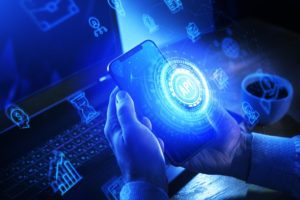
Beyond “User Experience” (UX), the next step is now real-time massive interactions, that is, “Collaborative Experiences” (CX).
Oversaturated information thrown at us at an increasing pace from multiple sources created impulsive consumers with an attention span of merely 3 to 5 seconds. This is how much brands have in their disposal to engage with their consumers, or even with their employees. It has been quite a ride to create mobile apps in this context, slick mobile user experiences.
But time has changed. Everything is real-time inside and outside the enterprise, with billions of connected smart things producing behaviors, both systems and people need to interact in real-time. The fourth industrial revolution is moving us from,User Experience (UX) to massive Collaborative Experiences (CX).
B2C – The blend of physical and digital worlds: banking
Let’s take the example of digital banks, that is, banking on a mobile app:
- What if there was a new type of digital bank blending the physical and digital world,
- Where you can collaborate with your customers to maximize engagement and loyalty?
Stepping in a bank with your mobile phone, you scan a QR-code and the bank agency can then sets itself up automatically to better serve you. Even more, the experience is transforming itself according to your needs and profile.
The bank already knows exactly why you are coming, you are indicated on a screen where to go, how long you’ll be waiting, and in the meantime, you can find a quiet place to continue the process of the request you started while in the public transport. This can be done either on your mobile or on the tactile screens available at the agency. Agency staff sees in real-time what you are entering, they can step in the process to assist:
- Physically sit with you to guide you
- Digitally help you through the screens, you get access to the right expert on the fly
- Access video content to help you understand a particular point.
There’s no physical versus digital bank, it is one single frictionless experience personalized according to your profile, taking the best of both worlds.
This is the end of single user experience and time for a new type of interactions both for end customers and colleagues, and not only for B2C.
B2B – Applications as agile as the business they represent
We are talking about the end of static applications where you write paper specs, you pass it on to developers, they produce the app and in between the requirements have changed so it is already obsolete.
In fact, you should almost never think about a single app anymore. With data changing all the time, when a small piece of data changes somewhere, it affects different departments and people, and that is why it needs to be reported in real-time and acted upon all the other applications too.
This means the application logic itself may need to be adapted right away, no time for long software cycles, business users need to be empowered to do such changes immediately.
In essence, it is about putting the “power of a software development team” in every employee’s pocket. This can only be done by leveraging on machines to do most of the coding. Business users know what needs to be done, they need a platform to experiment, test, adapt, validate, and finally scale up the solution by bringing onboard the right experts on the same platform, whether they are designers, developers, or architects.
This requires a new type of design between business and tech teams, focused on Collaborative Experiences (CX) with platforms like Olympe :
REAL-TIME
You need a technology where sharing real-time data is the default, not where it takes an army of developers to synchronize data between applications, front-ends and backends. In fact, with Olympe both UI, logic and data are real-time objects you can play with to assemble your applications.
NO BARRIER & IMMERSIVE DESIGN
No more restrictions, designers and business users can actually produce software on their own to test their ideas in the live business context. Immersive design is probably the right term. It is not static mock-ups anymore that get misinterpreted by tech teams, it is already a running app.
COLLABORATIVE PROCESS TO EXPLORE
Your mobile device can take control of other screens, you can share data and apps seamlessly with process-connected devices, no more boring forms to fill up, each user is visually immersed into the collaborative process which he/she fully sees and contributes to enhance it along the way.
- image Freepik
Connect What You Have, Create What You Need – Now.
 April 27, 2023
April 27, 2023  5 minute(s)
5 minute(s)